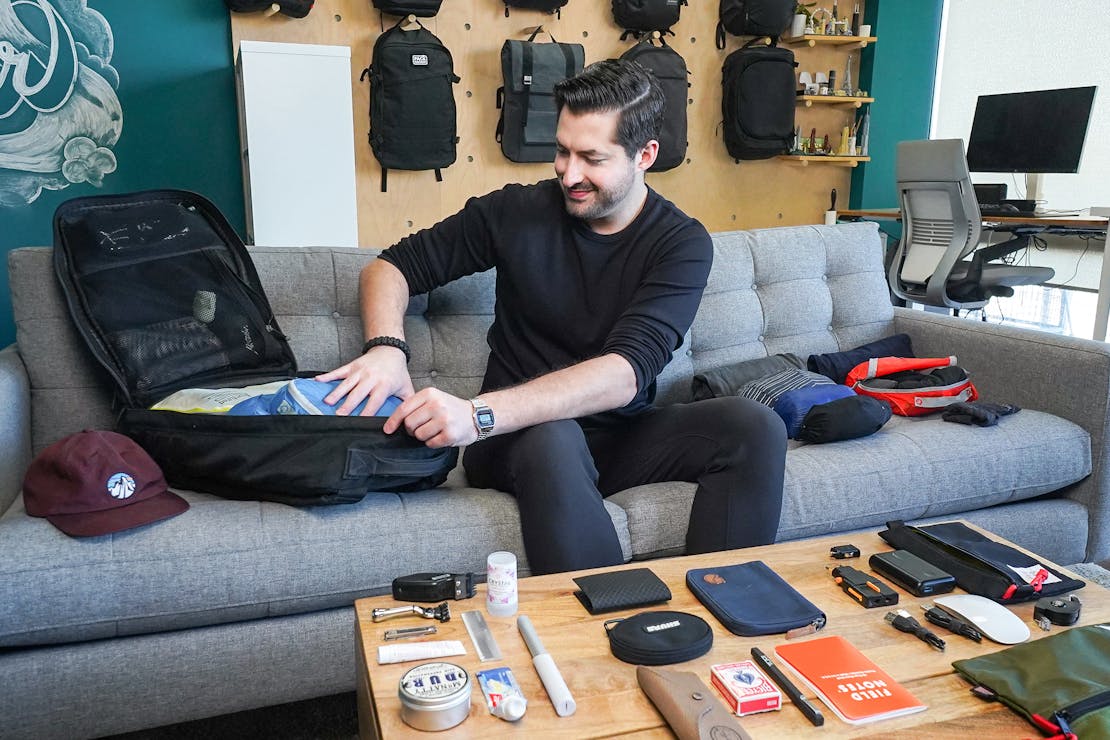How To Pack A Carry-On: Step By Step
If you've never traveled with just a carry-on, we highly recommend it. Why? Because it’s freeing. There’s no need to wait at the airport to get your checked luggage. You can breeze through security quickly. And you have everything you need on you at all times.
In most cases, a smaller carry-on-sized bag forces you to be mindful of what you bring, which means you won’t have to haul around bulky luggage or excess gear. Even if you jam your bag full, it’s still a relatively compact package.
In this post, we're going to walk you through step-by-step instructions for the best way to pack a carry-on.
The packing techniques we’re going to cover work great for long trips, short getaways, and everything in between. Some members of our team have traveled full-time for upwards of two years, using these packing techniques.
Before we get going, we want to let you know about Pack Hacker Pro—our growing community of minimalist travelers who are all about packing smarter, traveling lighter, and getting their hands on high-quality gear that lasts. We also offer some exclusive members-only benefits. Make sure to check it out if you want to help support our independent, unbiased reviews, guides, packing lists, and more.
Let’s get packing!
Step 1: Choose Your Bag
Which bag you choose will come down to your use case, travel style, and personal preference. We typically prefer to travel with a backpack as we find it takes carry-on travel to a new level. With a backpack, your hands are free. And you can navigate just about any terrain easier—from cobblestone streets to picturesque beaches—since you don't have to deal with the limitations of roller luggage.
If you're not sure what bag to get, we've reviewed hundreds of packs—and we've written a full guide on how to choose the best travel backpack—so we've got you covered.
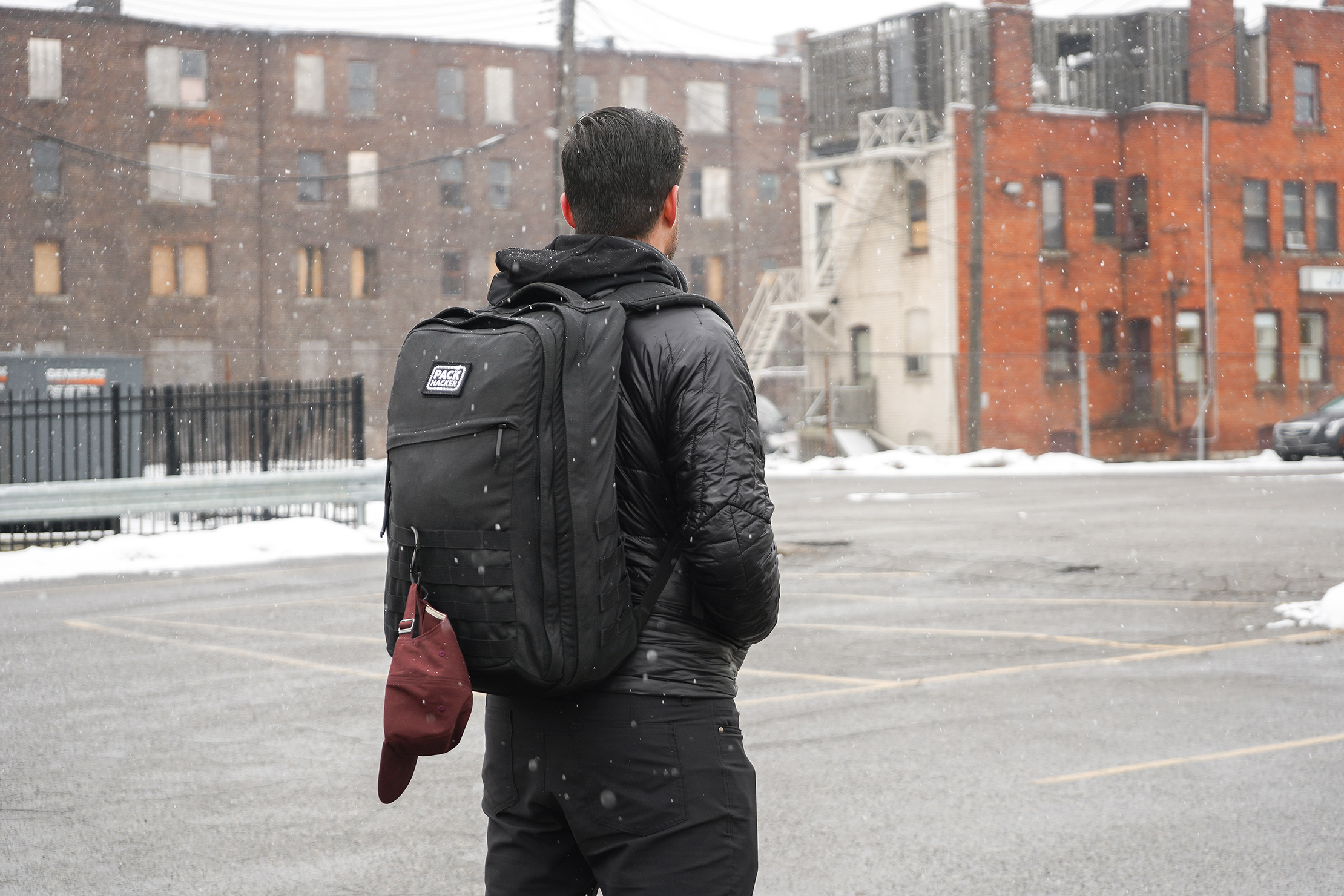
For the purpose of this post, we'll be packing all our gear into the GORUCK GR2—a 40L carry-on compliant backpack that's both functional and durable. But the same concepts apply for other travel backpacks, duffle bags, and rolling luggage.
If you’ve already got your bag, that’s great!
PRO TIP: If you choose a bag with a boxy shape, it’ll be easier to maximize the space inside.
Step 2: Lay It All Out
Now that you know which bag you'll be packing, it's time to find all the items you think you're going to pack, lay them all out, and get organized.
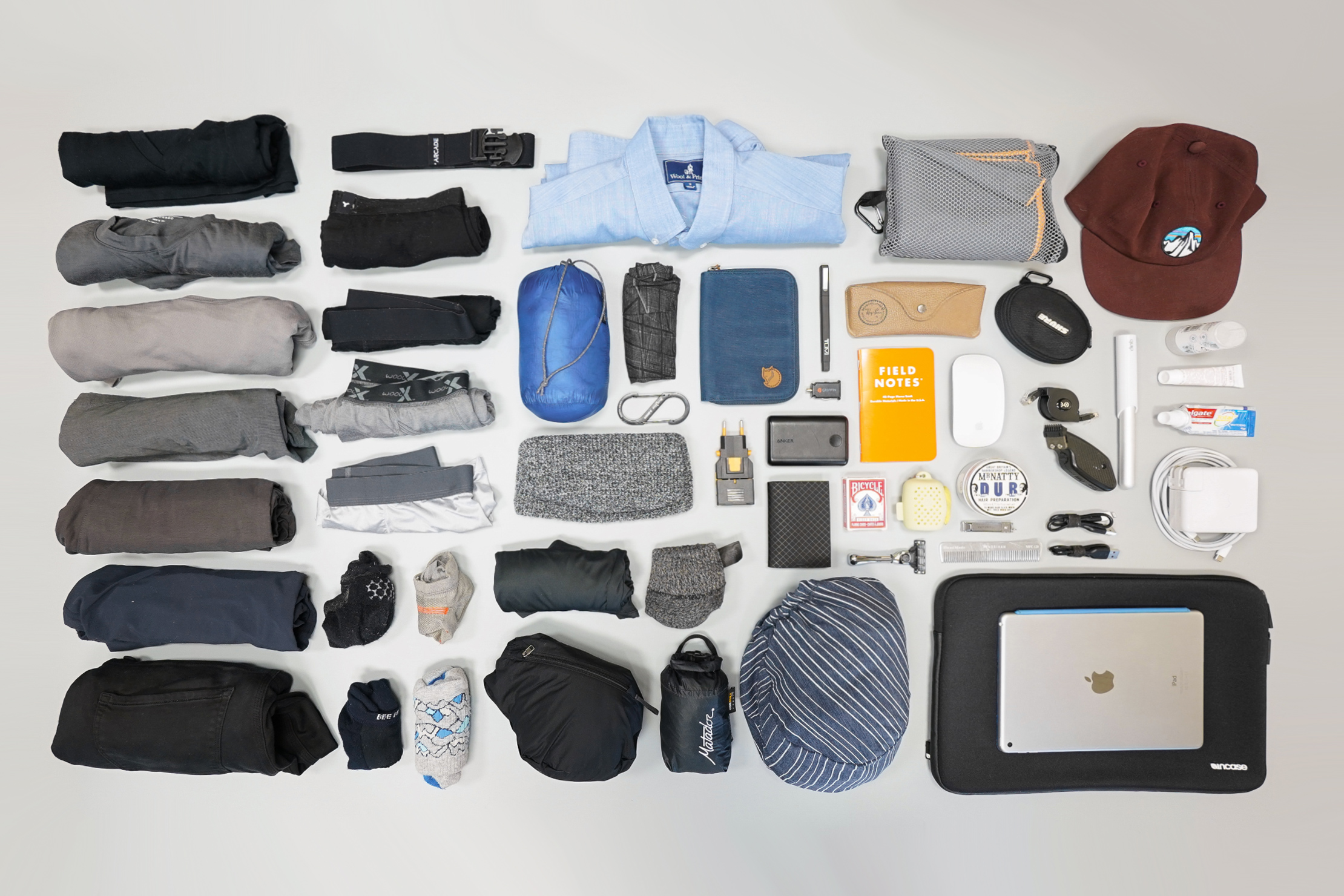
It’s important to lay your items out in a staging area where you can see everything you want to bring. You can use your bed, the floor, a kitchen or dining room table—whatever you’ve got. Just make sure that you have only the things you want to pack in this area. Nothing else.
You may be surprised by how much it helps to see everything holistically. It’s amazing. And it gives you a much better idea of what you’re going to need on your trip. What you’re packing depends on your use case—where you’re going, for how long, your travel style, etc. We’ve created comprehensive packing lists and have even written a detailed guide on how to create the best packing list for you—so check those out if you’re not sure where to start or are looking for smaller, lighter versions of what you already have.
Once you have everything laid out, it’s time to organize it. We've found three methods of organization that work well for us. Feel free to choose one or use a combination of all three.
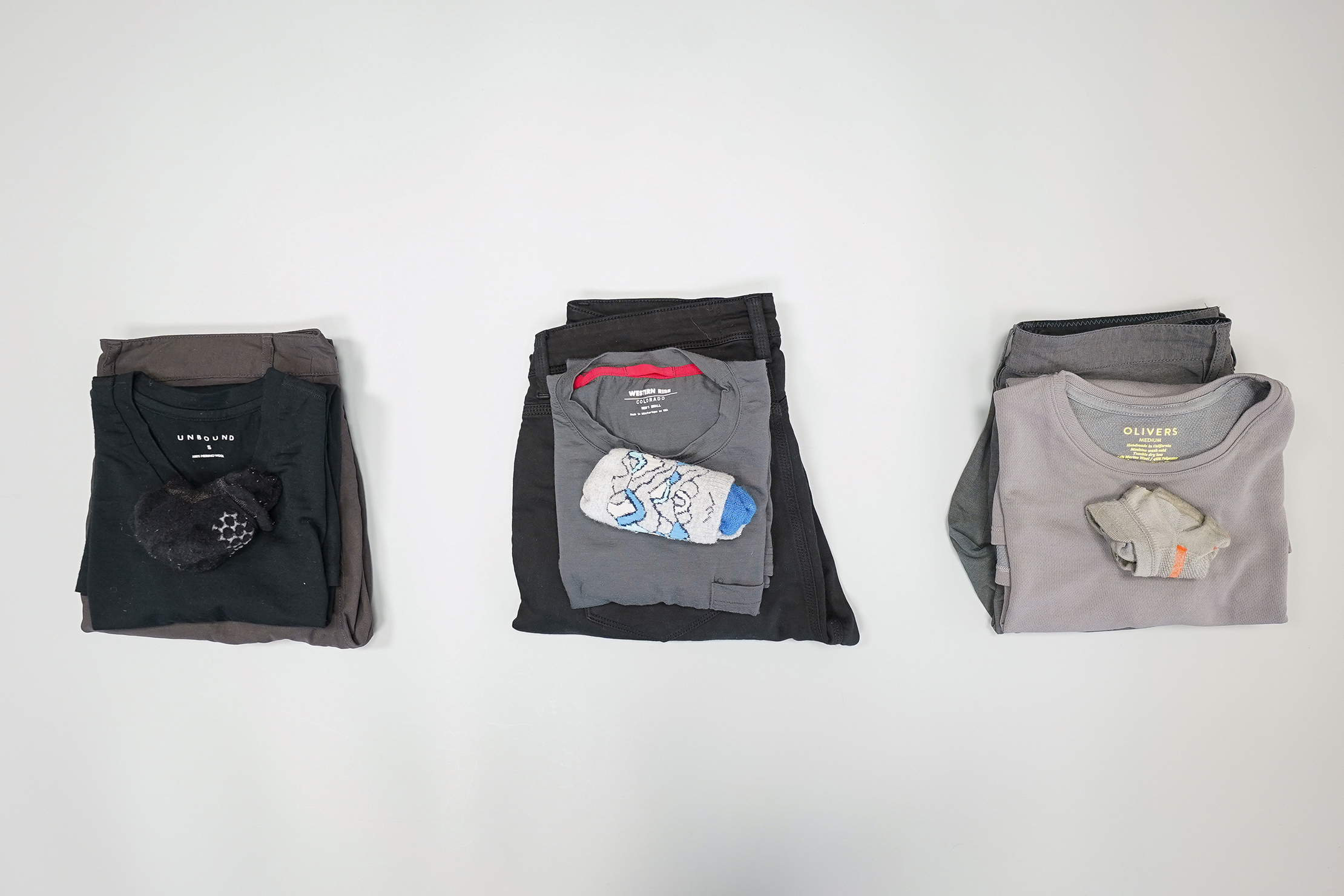
First, you can organize your gear by Context.
This includes packing complementary pieces that you will use together near one another. For example, you may pack a hat, buff, gloves, and a packable jacket to stay warm. So, organize those items together. Or you may bring a tablet, pen, and notebook for when you want to read, take notes, or work. You can put those items together as well. You can also organize by outfit, but keep in mind that all the clothing you bring on a trip should be easy to mix and match with most items you pack.
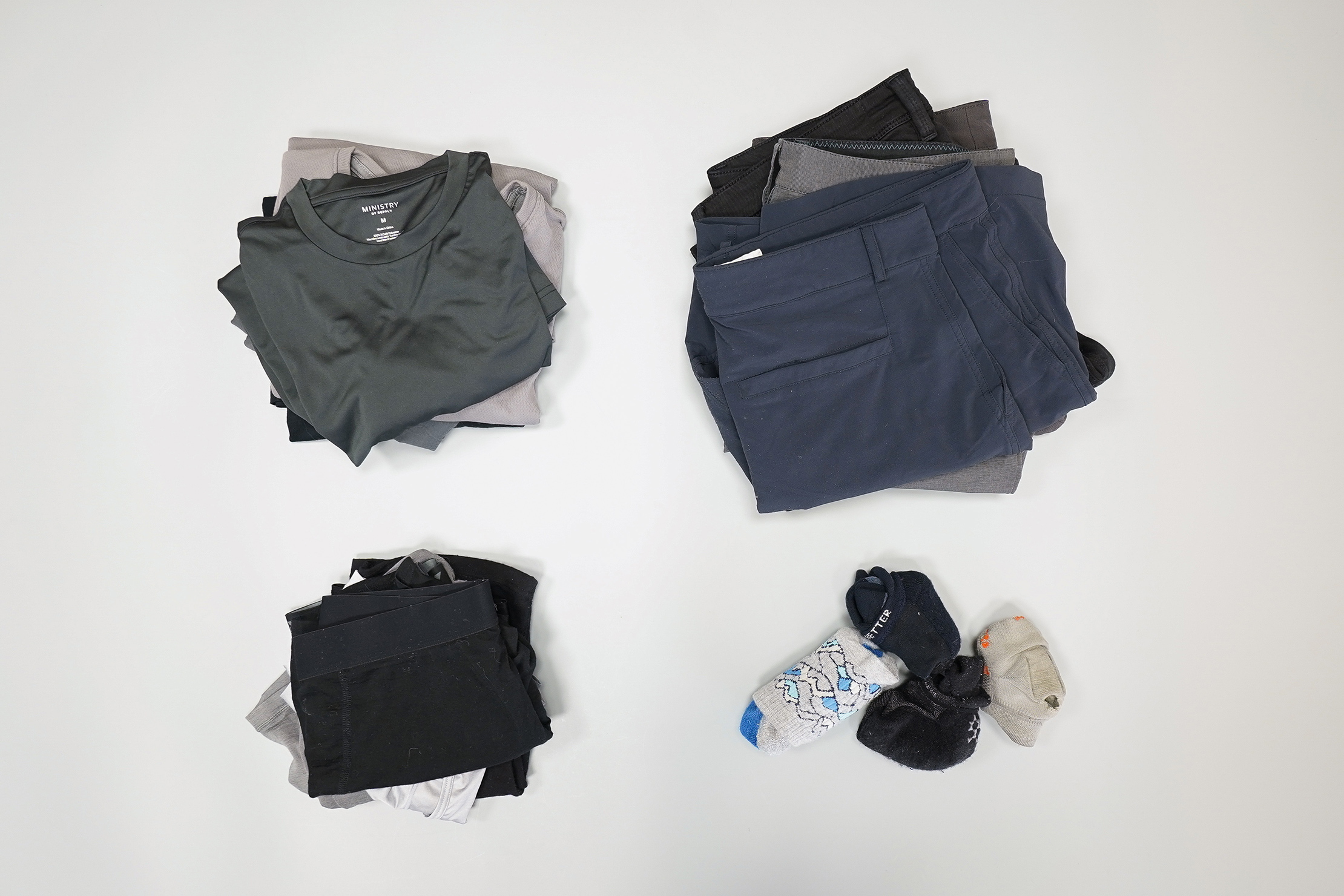
Second, you can organize by Type.
This method is easy—simply organize similar objects with one another. Put all your socks in one pile, all your underwear in another, your t-shirts in another, and so on. This system works well if you're packing with smaller organizer pouches or a bag that has a lot of internal organization since you're able to keep things separate. It also works well for larger, bulkier items that will stand alone in your bag.

Third, you can organize your items by Category.
This method is similar to Type but is a bit broader. For example, instead of sorting just your shirts, you'll pack all your tops together—t-shirts, button-ups, sweaters, etc. Then, put all your bottoms together—like pants, underwear, socks. This method works great for toiletries too.
We typically pack with a combination of all three methods. (Pretty crazy, we know.) Let's run through how we do it, shall we?
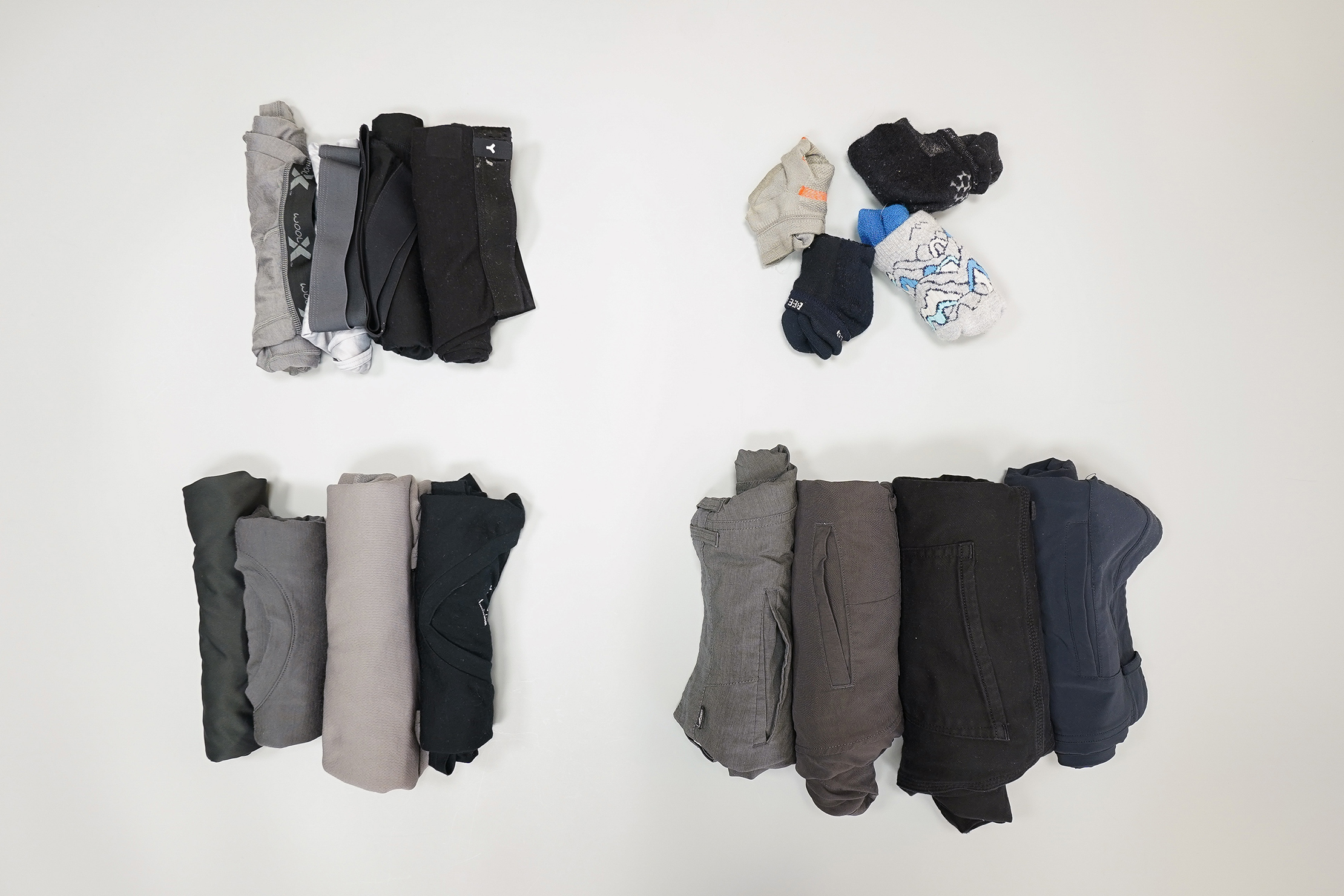
We'll start by organizing some clothes by Category. We like to separate our bottoms from our tops. For bottoms, we have four pairs of socks and boxers, two pairs of pants, one pair of shorts, swim trunks, and a belt. For tops, we have one button-up shirt, three t-shirts, and a long sleeve t-shirt.
With each of these neatly (or neatly-ish) grouped together in our staging area, we can continue organizing the rest of your gear.
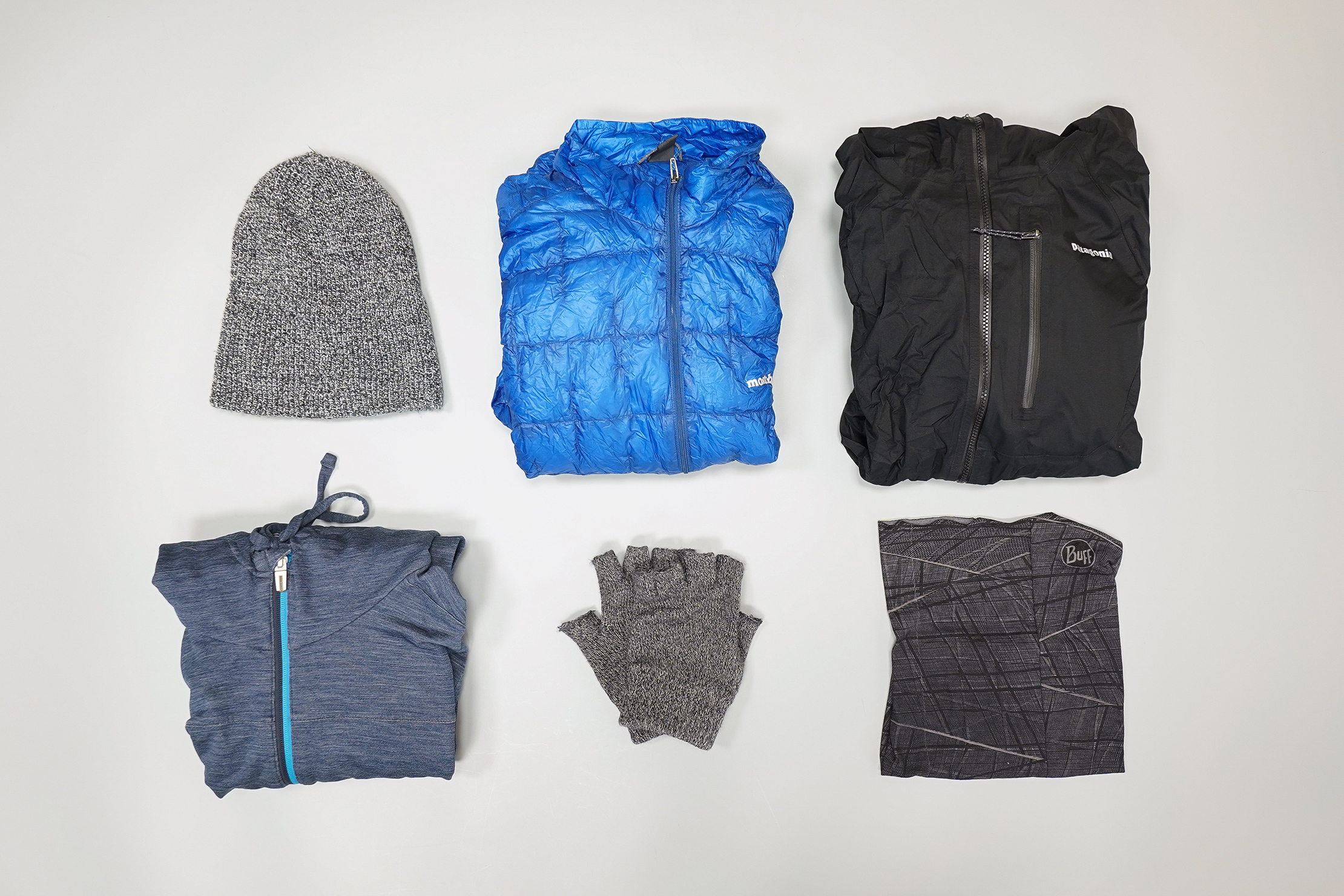
Next up, we’re going to sort our outerwear by Context. We keep everything we need to stay warm in one place so it's packed away if we're in warmer climates. So, our next grouping consists of a hat, compressible jacket, hooded sweatshirt (Merino wool, of course), a rain jacket, BUFF, and gloves. We've found that you're probably going to want easy access to all of this stuff if you get cold, so keeping it together just makes sense.
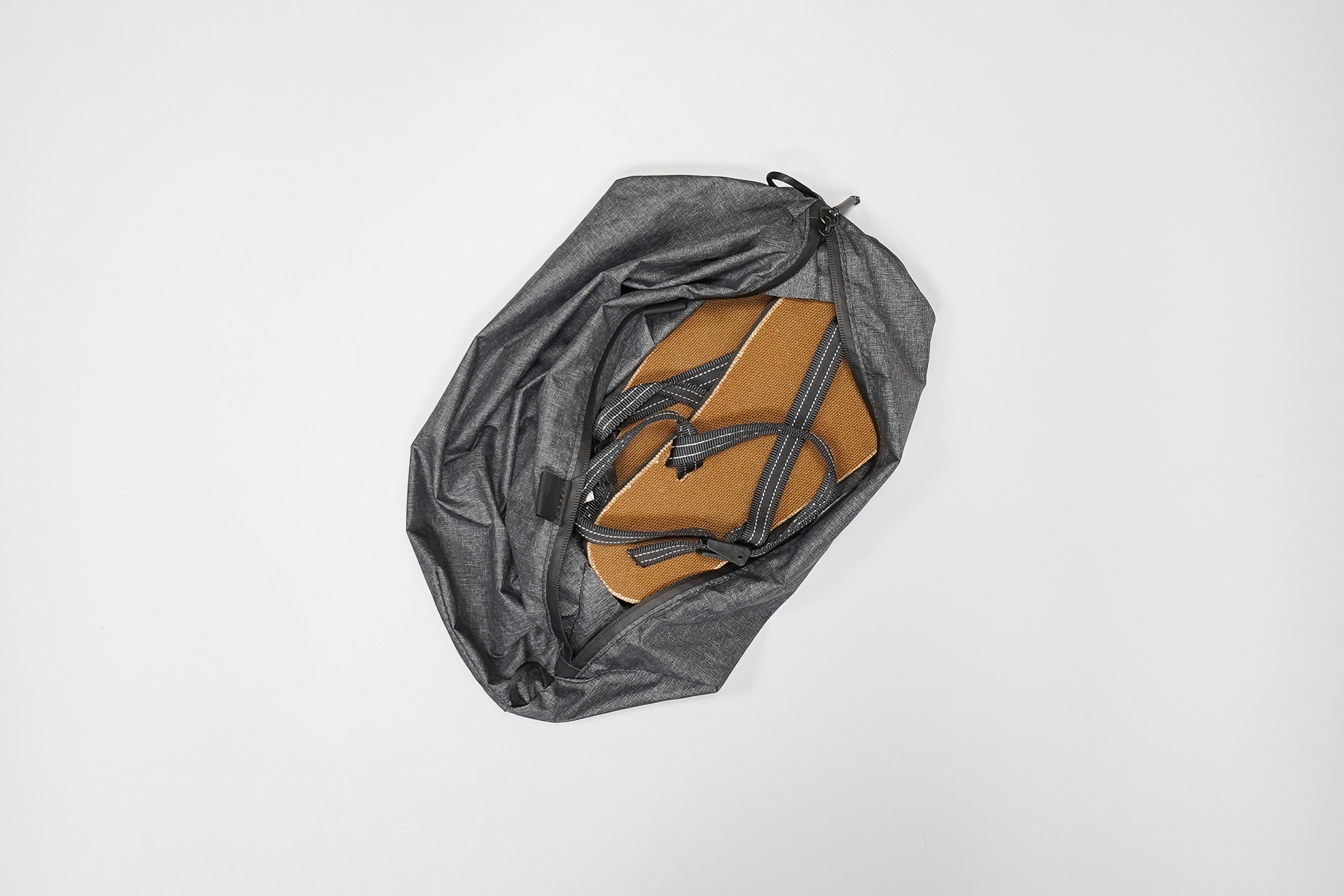
For larger items, we tend to organize by Type. It nice to keep your shoes and sandals separate from your other gear, just in case they get funky. Plus, the ground can be pretty gross, you know? We also separate out our button-up shirt so it doesn't get wrinkled or dirty.
Now, if you're paying close attention, you'll notice that we've already sorted the button-up shirt into the tops category but are now keeping it separate. That's totally okay—this is why we have everything laid out.
PRO TIP: Travel with wrinkle-resistant clothing, like Merino wool, because it’s easy to roll and pack without worrying about creases.
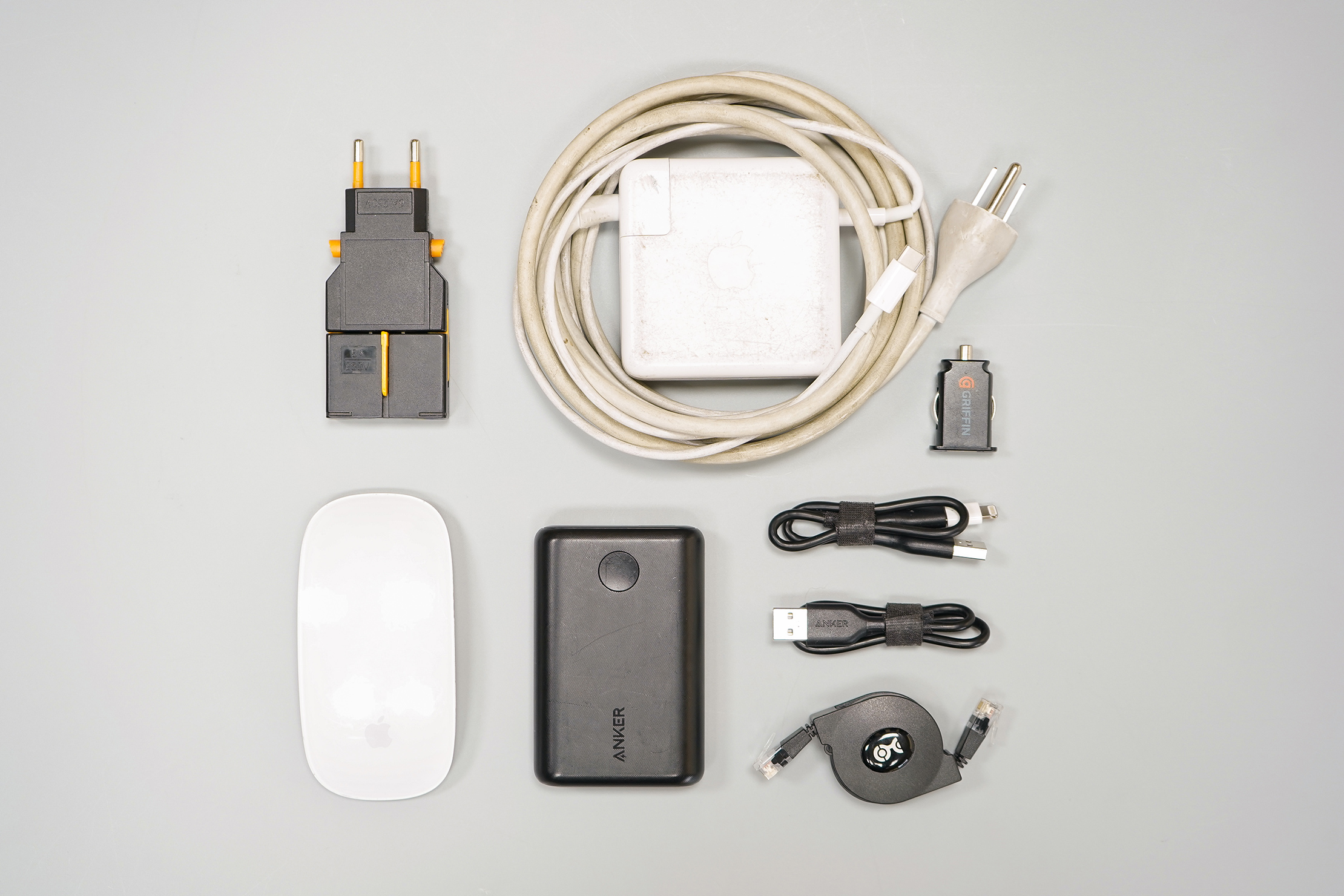
Moving onto our accessories, tech, and toiletries. We group our devices—like a laptop and tablet—together since they’re a similar Type. We sort our two differently-sized travel towels this way too.
For cords, chargers, adapters, battery banks, etc. we usually organize by Context. You'll probably want access to all of this stuff when charging electronics or working on the road.
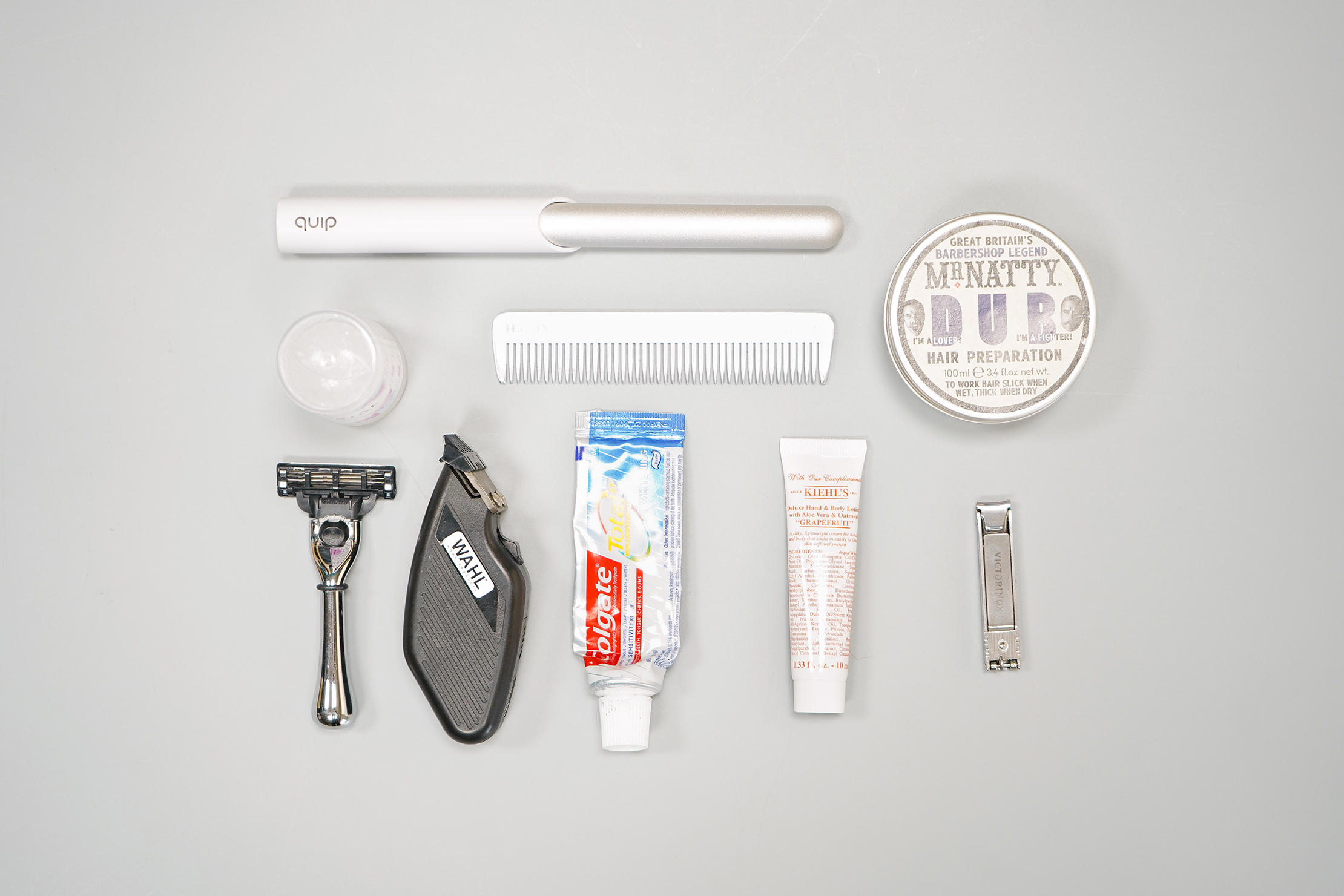
All of our toiletries will go together since they’re in the same Category.
Outside of those items, we have a few leftovers that are not organized into categories—a packable daypack, wallet, notebook, deck of cards, passport wallet, and sunglasses. We're not exactly sure how to sort these yet and that's okay. We'll figure it out when we pack the bag (that step is coming, we promise). The important part here is to get the obviously similar items together in one place and work from there to get organized in a way that makes sense to you.
PRO TIP: Consider what you can wear in transit to free up space in your bag.

One last thing to consider in this step is what you can wear while in transit, instead of packing it in your bag. For example, you can add a whole additional outfit (not accounted for in the list above) if you plan on wearing it, not packing it. Or, you can lighten your load and make extra space in your bag if you take out one of the outfits and wear it instead.
The common items most people wear in transit include a belt, a hat, bulky shoes, a jacket, or a sweatshirt. Or some combination of them all.
Now, as we said, these are the methods of organization that work best for our gear and travel styles. (And we think they'll work well for you too.) If you've found another system that works for you, great! Use it!
Step 3: Compartmentalize
Now that you have everything laid out and organized using your preferred method, it’s time to compartmentalize. Start by sizing up your groupings and deciding the best way to compartmentalize the items. Basically, figure out how you want to keep these groups separate in your pack.
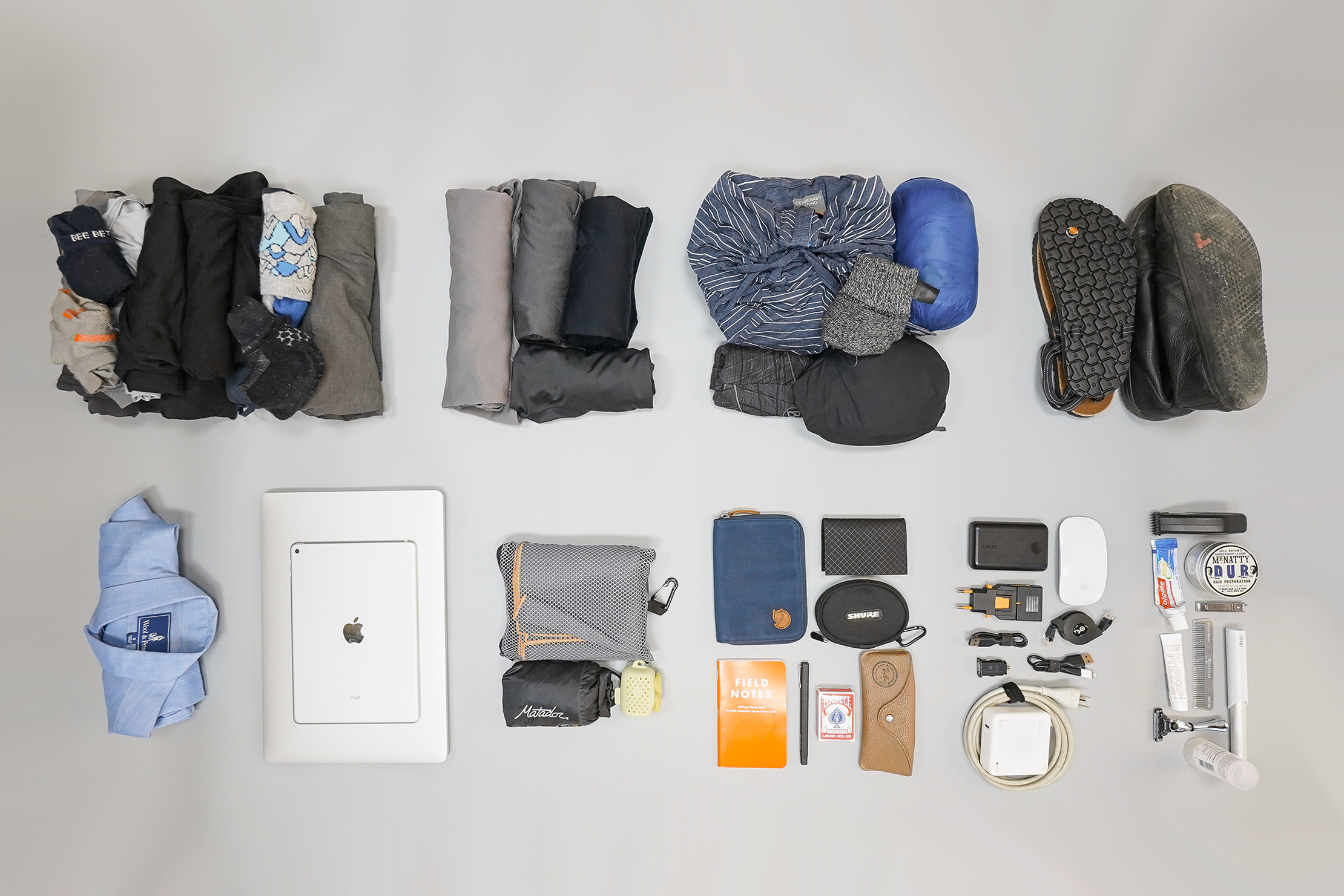
You can pack all your stuff directly inside your bag—making use of any built-in organization if that's your style. Or you can divide your gear into packing cubes and other organizer pouches. You can even use trusty old Ziploc bags and rubber bands to hold stuff together (they're handy to have on the road, plus you might have some already lying around).
We’ve found packing cubes, pouches, and Dopp kits to be invaluable companions while we’re on the road—so that’s how we like to pack our gear. Let’s start with clothing.
PRO TIP: Pick up packing cubes in different colors to further organize your gear.
The first thing to do is to fold your clothes. Now, there are a bunch of fancy folding methods out there—which we might cover at a later date—but we tend to keep it simple. And by simple, we mean we roll them. We've found that rolling your clothes makes them more packable and helps combat wrinkles a bit.
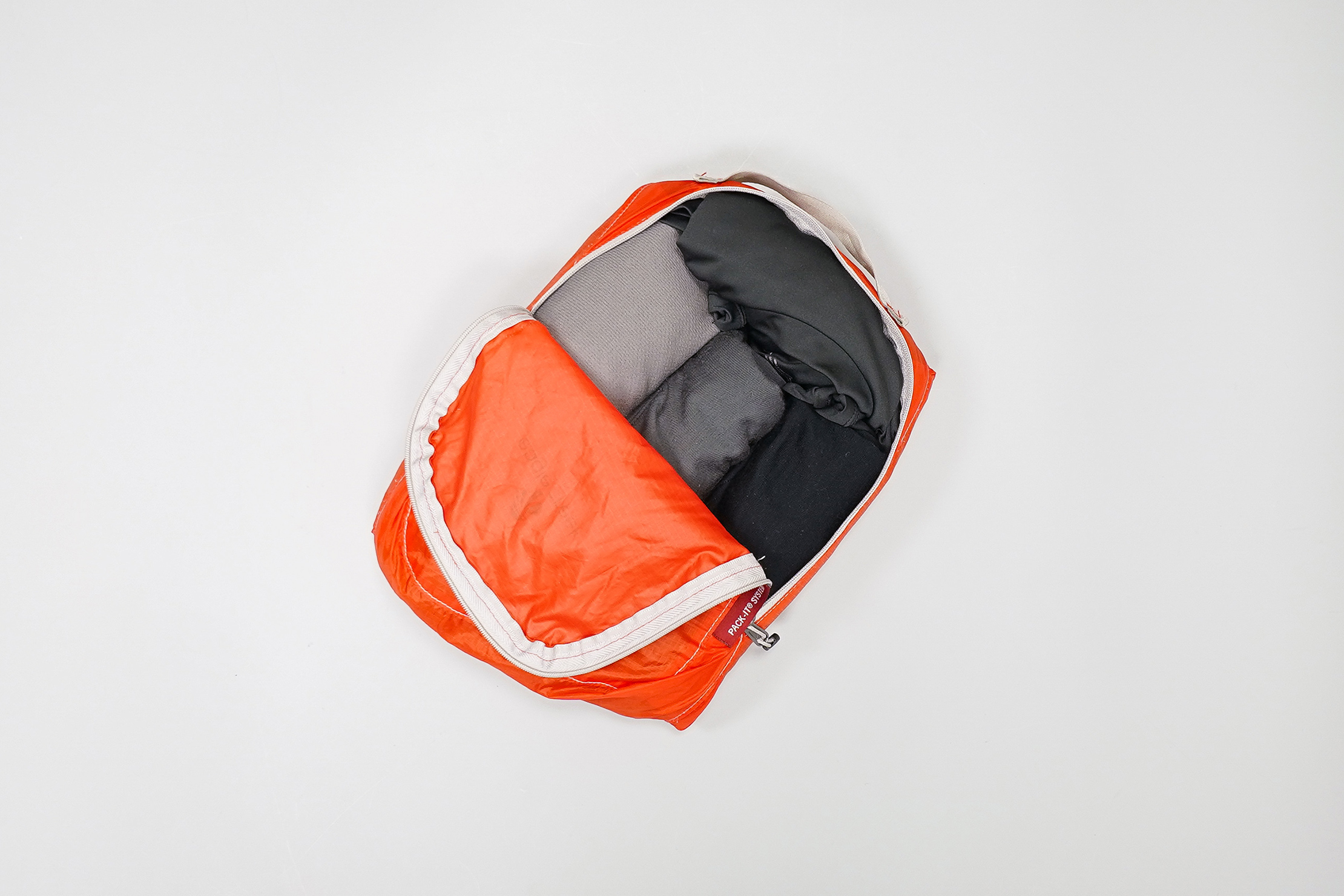
So, let's take all those bottoms we sorted earlier, roll them up, and place them in a larger packing cube. Large packing cubes are great to keep around for your bulky clothing items. If you're new to the world of packing cubes or are looking to up your game, check out our Ultimate Packing Cubes Guide—it has everything you need to know about these helpful organizers.
Next, we'll roll up all our tops and put them in a medium to small-sized packing cube. We'll also pack that button-up shirt we separated into its very own packing cube to give it a little extra space and avoid wrinkles even more.
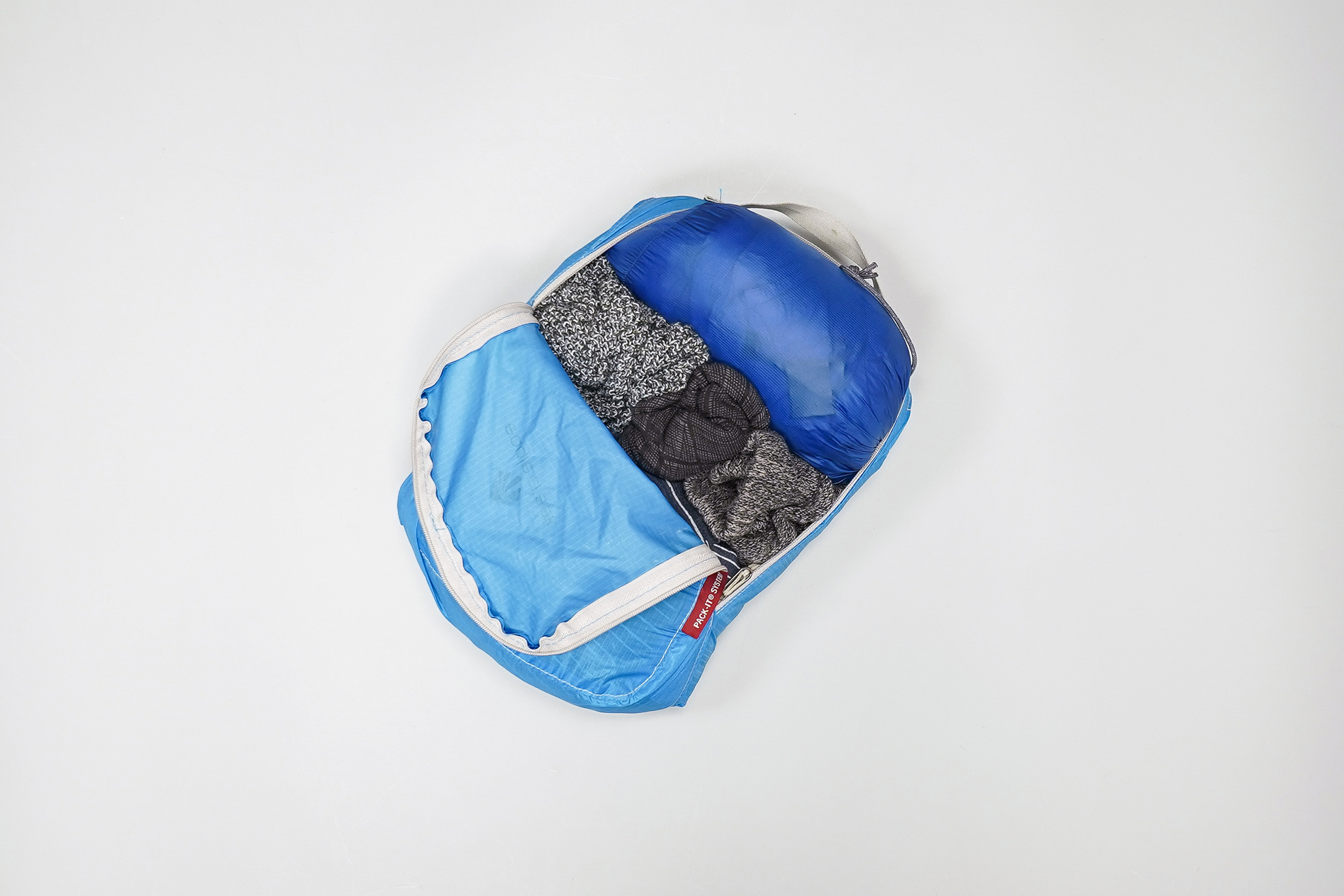
All of our cold-weather gear (sorted by Category) will be stuffed into a packing cube together. It's a good idea to leave your rain jacket out (loose inside your bag) so you have quicker access in case you get caught in a sudden storm.
Wrapping up the clothes, we usually keep our sandals in a separate shoe pouch. That way, if they get dirty, sandy, or otherwise gross, we can keep them out of contact with the rest of our gear. For bulkier shoes—as in, not sandals—we'll wear those in transit. No need to pack them. We also like to travel with a baseball hat, which you can wear, toss at the top of your pack, or attach it to the outside with a carabiner.
PRO TIP: Bring a carabiner to hang wet stuff, shoes, a hat, whatever else, on the outside of your bag.
Okay, moving on to toiletries and tech. Compartmentalizing toiletries is easy—simply put them in a dedicated toiletry case or Dopp kit (whatever you want to call it).
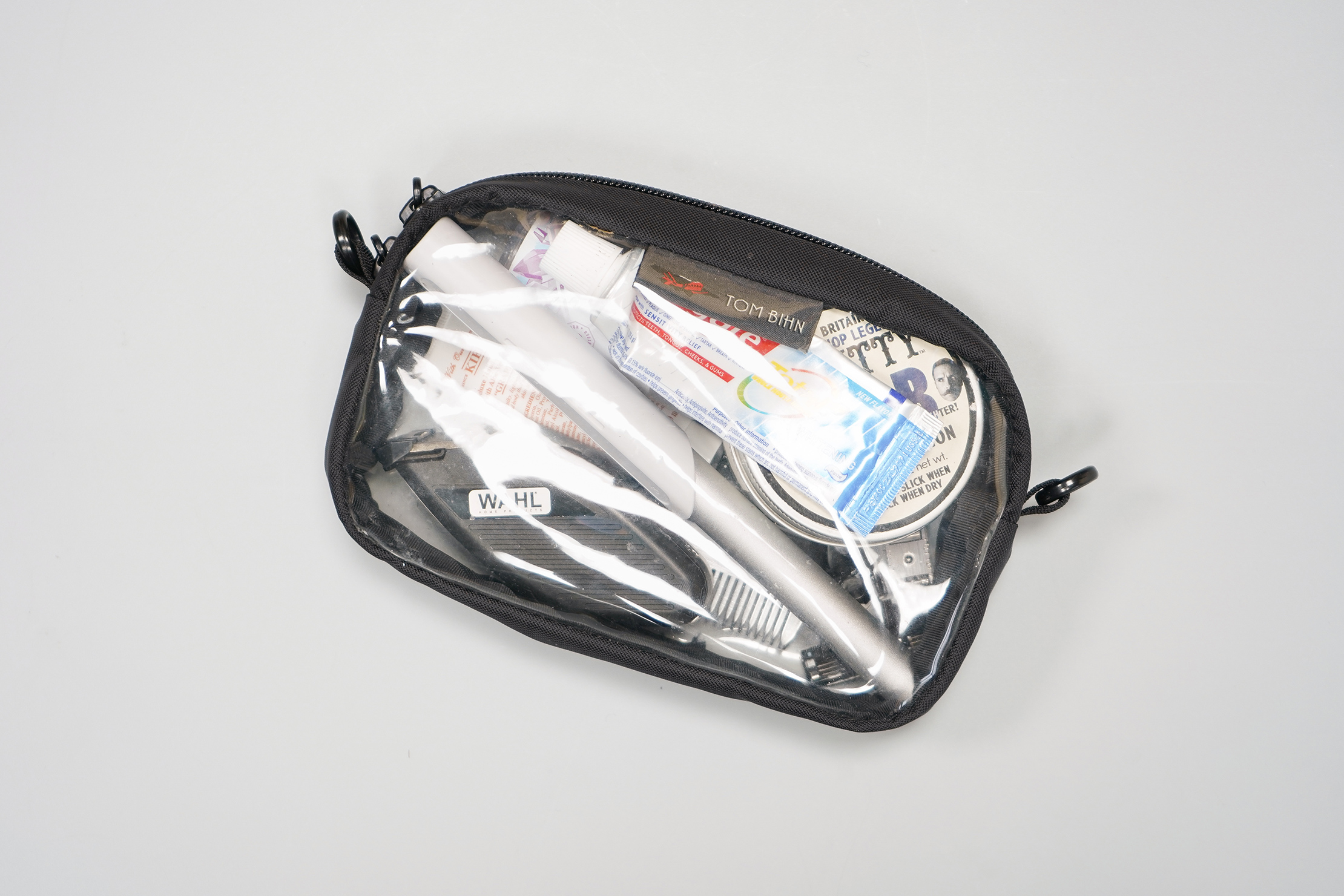
For example, on the grooming side of things, we'll bring nail clippers, a comb, trimmer, razor, and a toothbrush. As far as consumables are concerned, we'll bring hair pomade, lotion, toothpaste, and deodorant. And everything fits neatly inside a Dopp kit. Of course, your mileage may vary based on the toiletries you bring.
Two things to keep in mind when figuring out your toiletries.
1) Try to find the smallest versions of everything you can. Full-sized toiletries and grooming tools can get bulky, so if you can shrink down your razor, toothbrush, even nail clippers, it'll make packing much easier. You can also use small containers—like the humangear GoToob+—to shink your liquids and leave those big containers at home. This is especially important for carry-on travel as all your liquids must be TSA-compliant.
2) A Dopp kit with a clear window is great for packing your TSA-compliant liquids. And it's even better if your toiletry bag is weather-resistant or waterproof so if any liquids leak, they won't spill all over your bag. (No one likes to open their bag to find out a shampoo wrestling match happened somewhere over the Atlantic.)
PRO TIP: If your toiletry case isn’t clear or windowed, bring a separate quart-sized Ziploc bag to house your liquids—under 100ml or 3.4oz, of course!
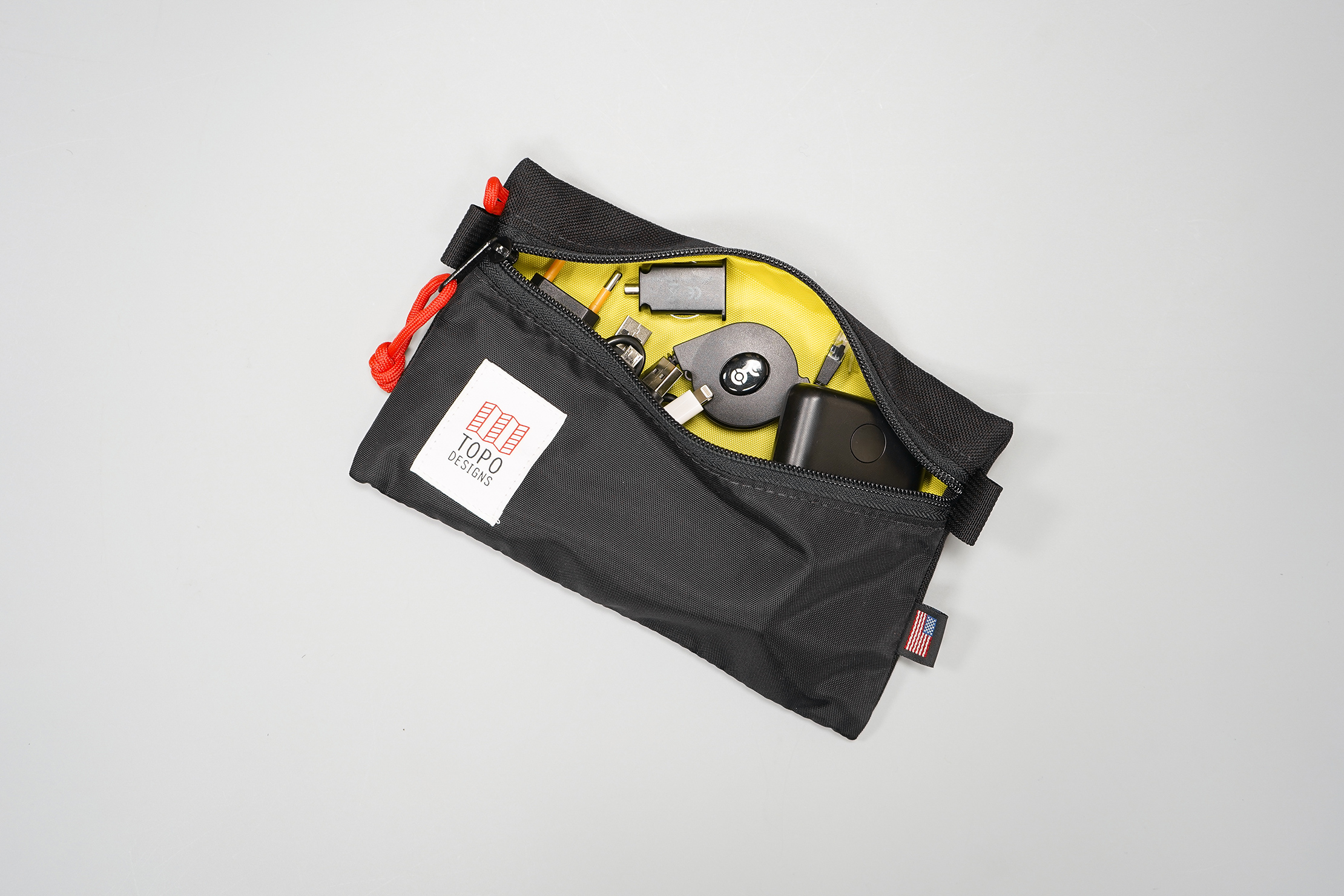
Finally, if you're traveling with tech (which we usually are), you're going to want a way to keep all those cords and such organized. We usually recommend tech pouches. The size of the tech pouch, and how many you carry, will depend on your kit.
We're going to pack the items we laid out and organized in Step 2, into two separate pouches. One pouch will hold the smaller cords, cables, chargers, and a battery bank. The other will be for larger items like that unwieldy laptop charger.
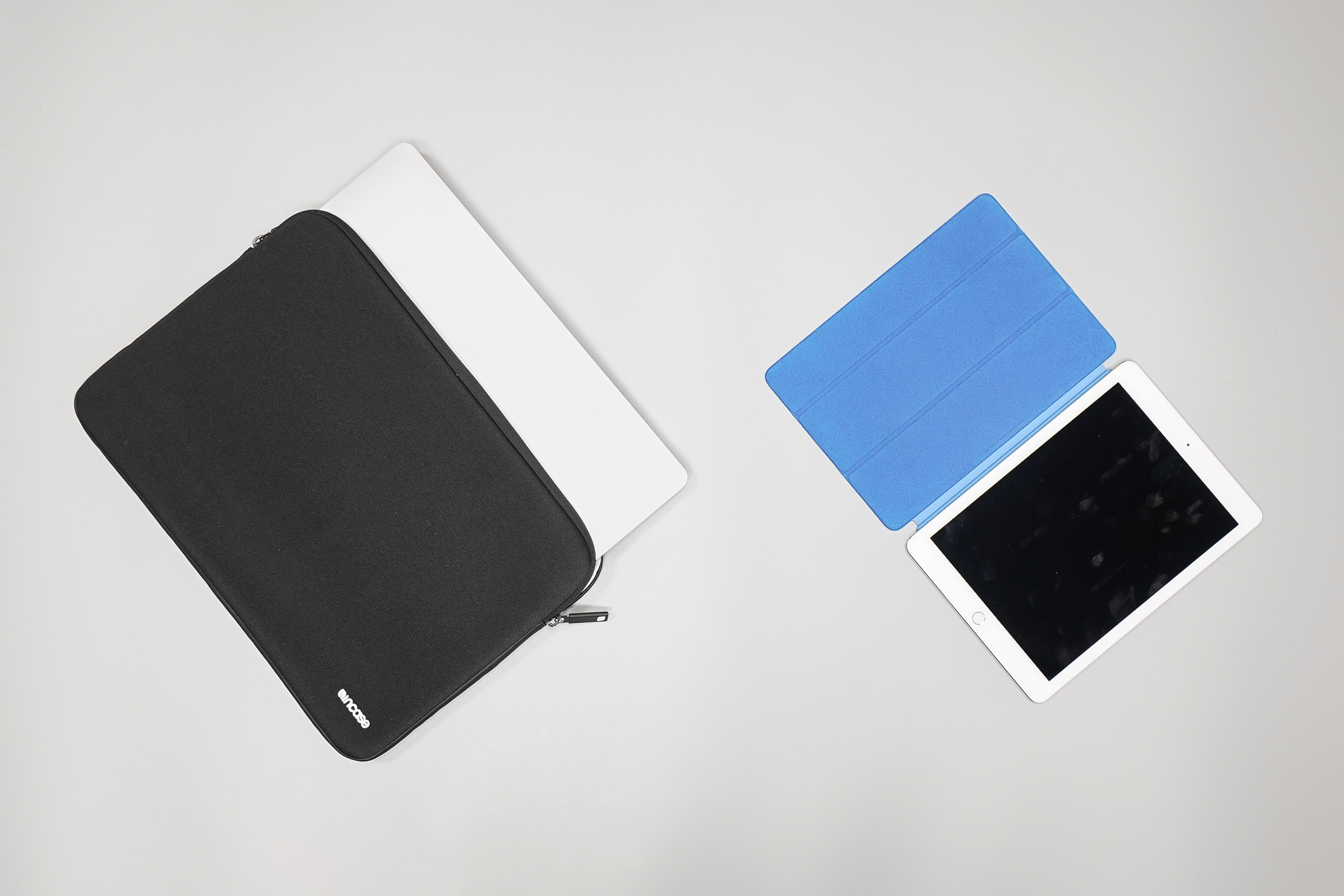
We also prefer to travel with any laptops and tablets inside protective cases. Laptops are expensive after all—and can be vital for you to make a living, depending on what you do for work. So having a case gives you a little extra peace-of-mind that your computer will be safe while hopping from plane to train to coffee shop.
At this point, you should have all your gear organized and compartmentalized into neat little groupings or packages. Be honest—it's super satisfying to look at, isn't it?
Step 4: Pack It Up
Whew. Take a deep breath—you’re almost there. It’s time to pack the bag up, strategically.
Since clothing is the largest item, we like to start there. Like we mentioned oh-so-long ago near the beginning of this post, we're going to be packing all the gear we've compartmentalized into the GORUCK GR2.
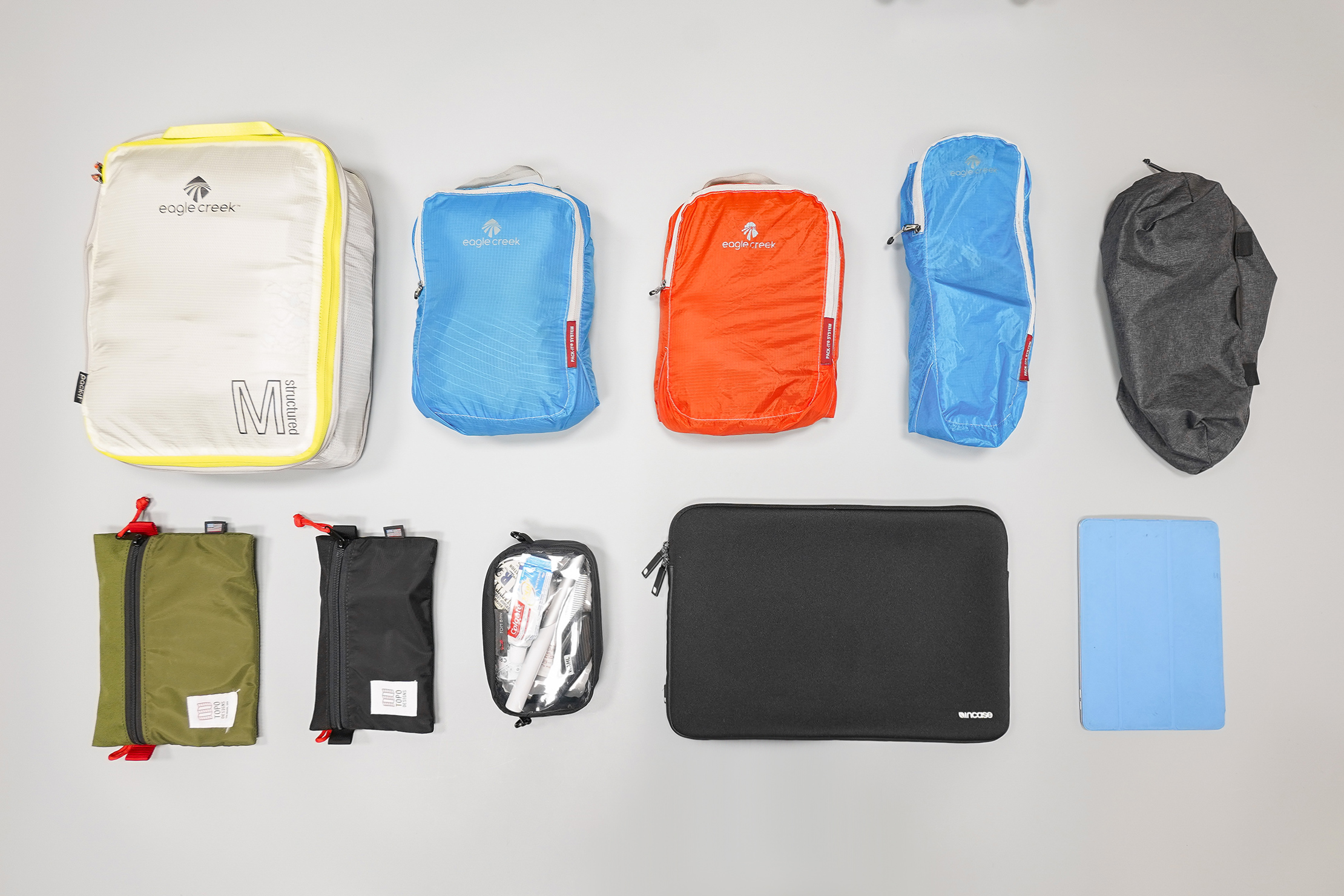
Now, if you're traveling with a backpack, it's typically better to have your heavier items as close to your back as possible. And try to keep them in the top third of your bag. This will help distribute the weight and make more comfortable to carry on those long travel days. If you're packing up a duffle bag or rolling luggage, this is less important.
First, we'll place our sandals at the bottom of the bag, followed by the four packing cubes full of clothes.
PRO TIP: Pack in flat layers like you’re laying bricks or a foundation on a house.
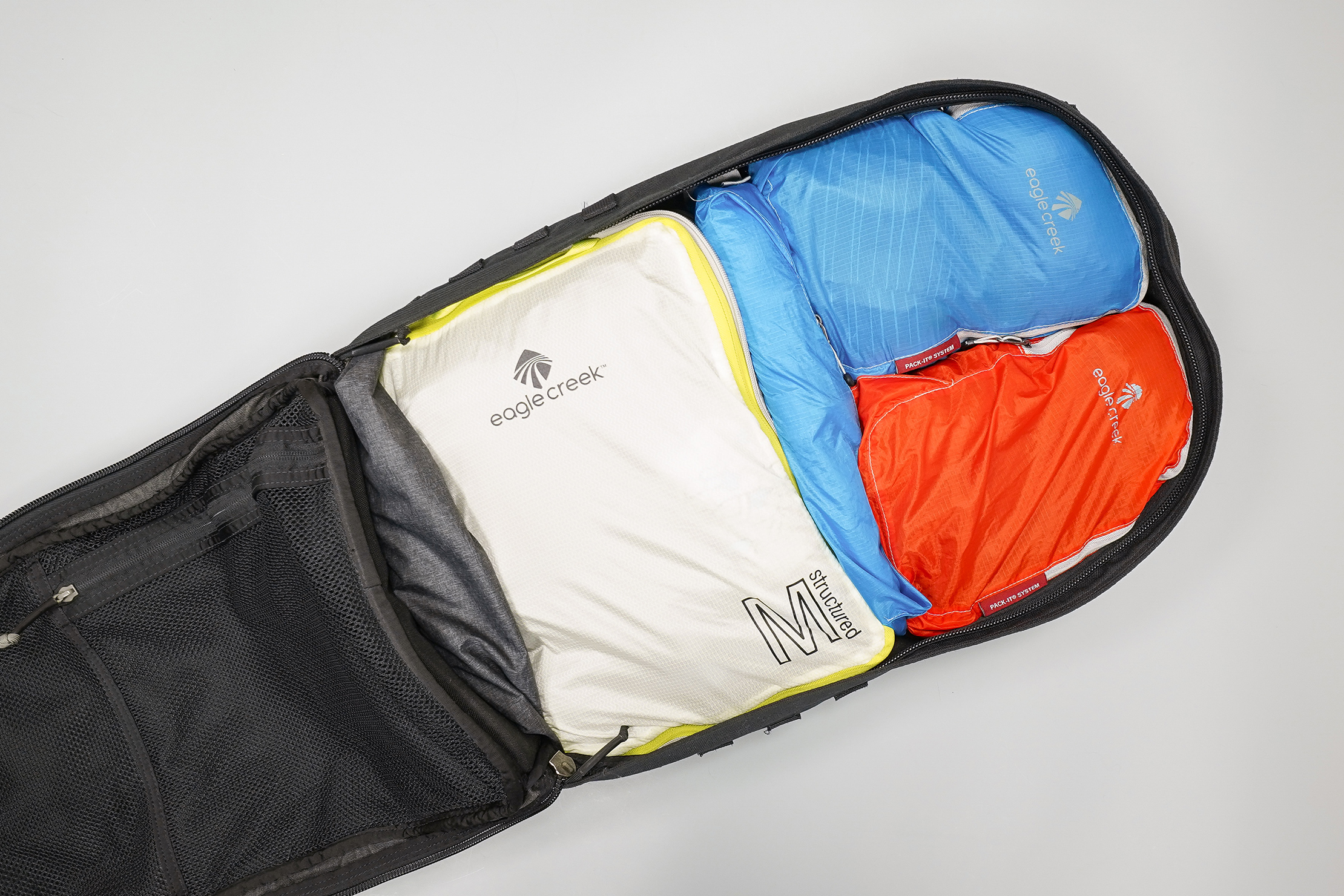
Packing your clothing flat will make it easier to maximize the space in your bag without any unexpected bulges that make it hard to zip closed. (Just because you've seen people sitting on their bags in movies, struggling to get them shut, does not mean you should make a habit of it.)
If you're a Tetris wizard, you'll probably love this step. There's something so satisfying about fitting everything in its place just right. Plus, most packing cubes are designed to fit inside bags, which makes this packing process even better.
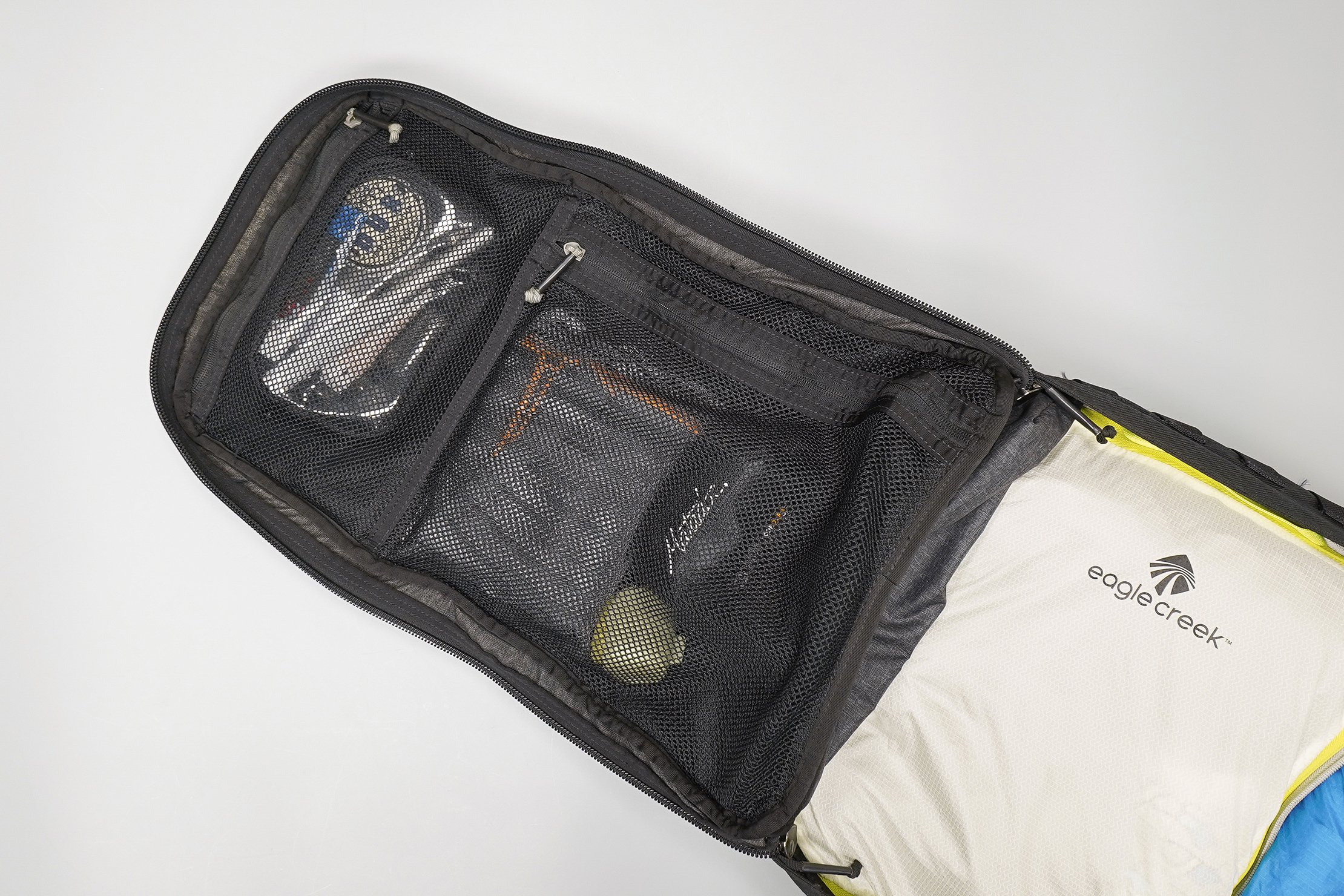
Next, we're going to use the mesh pockets on the GR2 to pack some of our free-floating items. The two microfiber towels and packable daypack we're packing can go here because they pack pretty flat and we don't need quick access to them. The mesh pocket above that is a good place to store toiletries—it'll be easy to unzip the bag and get them out for airport security.
Note that although your bag of choice will have different organization (unless you've picked the GR2), the idea is to use the internal pockets to pack the gear you don't have compartmentalized into other pouches.
Now that our main compartment is full, we're going to move to the secondary compartment on the front of the bag where there's plenty of room to store our tech pouches, tablet, and other loose items.
PRO TIP: Leave a quick-access or exterior pocket empty so you can quickly dump items from your pockets into your bag as you’re going through airport security.
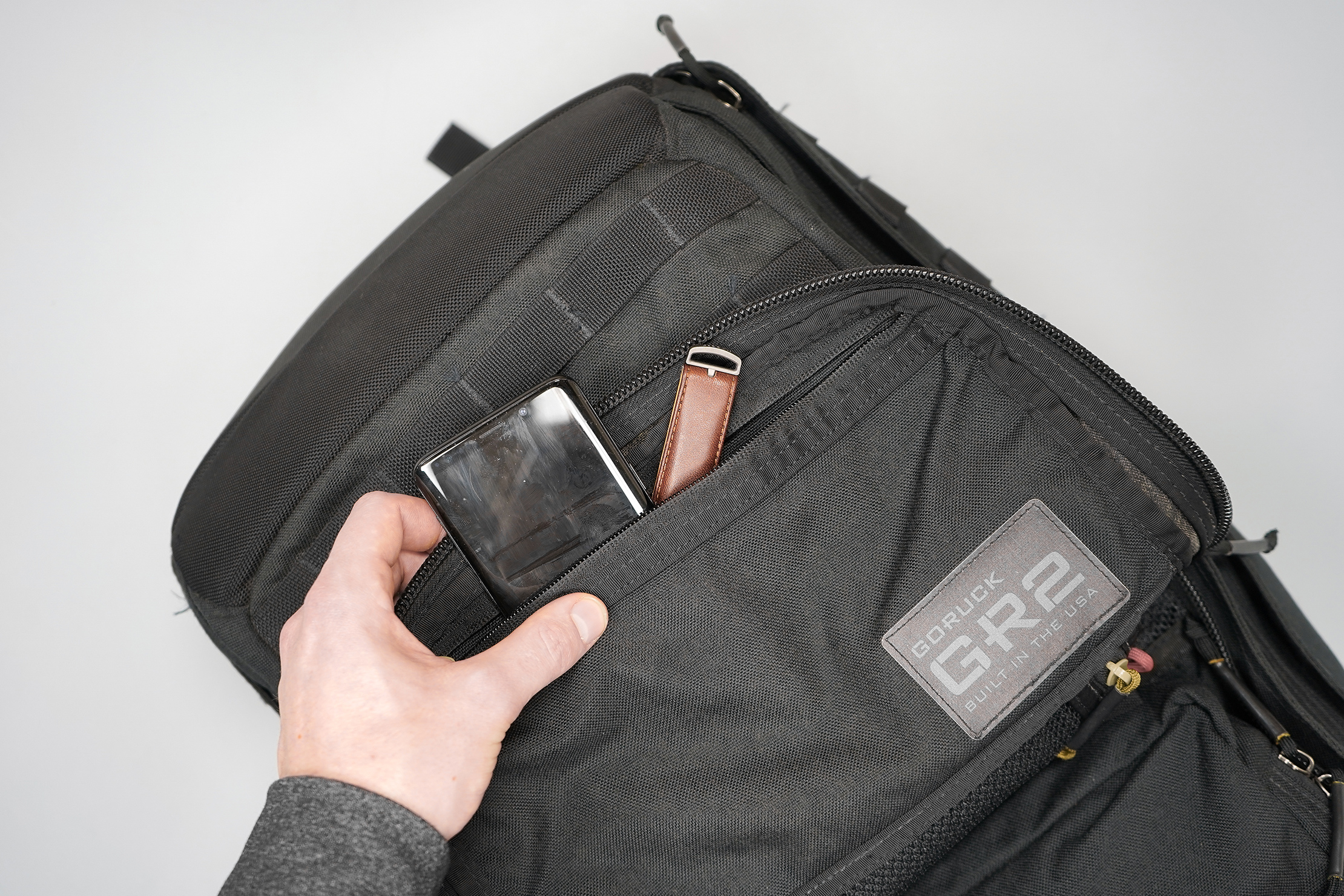
The GORUCK GR2 has a zippered pocket that's ideal for smaller items that you want easy access to. Things like your passport wallet, regular wallet, sunglasses, headphones, a notebook and pen, a deck of cards, etc. Again, while it's handy to have this type of compartment, another organizer pouch or Ziploc bag can do the trick too.
Finally, we'll pack the laptop in the dedicated laptop compartment and the rain jacket in an exterior pocket so it's ready to go.
Step 5: Practice Your Trip
You've made it to the fifth and final step, which is perhaps the most important—and the most overlooked.
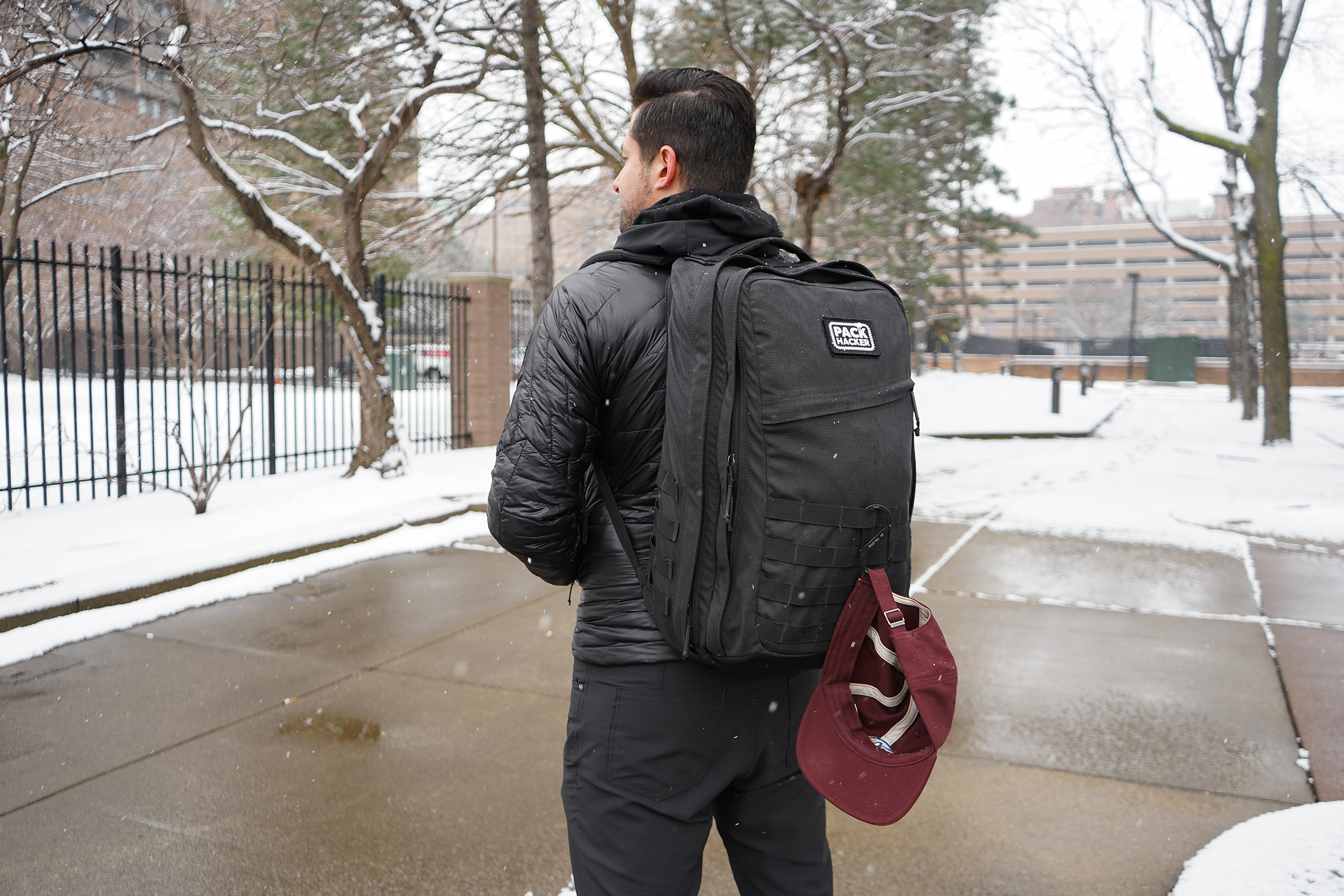
Now that you have all your gear packed up exactly how you'll be traveling with it, try living out of your bag/suitcase for a couple of days (a week is even better!) at home before you leave for your trip.
Take your bag to work, go on a walk around the block with it to feel the weight, generally just live as if you were on the trip already. Try to use only the stuff you have packed. This will make you mindful of what you actually need on the trip, and what you can leave behind. Anything you don't need during the trial run, you can probably leave at home.
It can also help you remember items you would have otherwise forgotten—like those things you use all the time so they didn't make it into your initial staging area (looking at you, phone charger).
PRO TIP: After you’ve practiced your tip, unpack your bag and reassess your gear. Remove what you didn’t use and add it anything you’ve been missing.
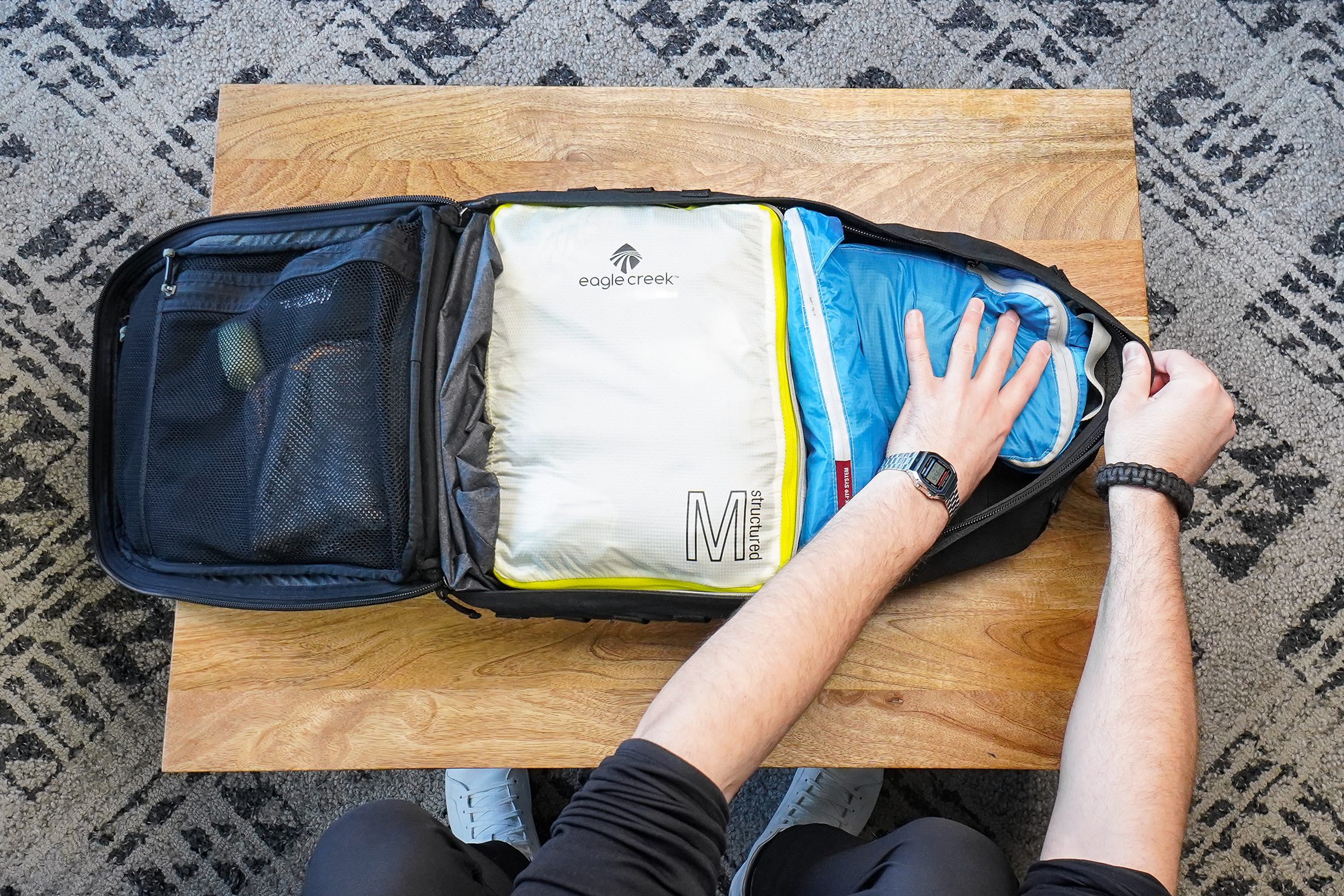
You can use this strategy after you’ve taken multiple trips as well. Keep track of what you use frequently and what you don’t use. Each new trip, you can probably start leaving more and more behind as you get more comfortable traveling with less.
The goal is to pack as light as possible, which makes travel smoother and more seamless. You don't have to worry about lugging around a ton of heavy gear and you can usually explore more since you won't have a heavy pack weighing you down.
The more you travel, the more you’ll optimize and tweak your setup to make it the best for you. Heck, we learn something new every time we travel—even after countless flights.
Time To Hit The Road
So, there you have it—the best way to pack a carry-on for travel, step by step. We hope these instructions help you pack lighter and travel smarter.
To recap:
Step 1: Choose Your Bag
Step 2: Lay It All Out
Step 3: Compartmentalize
Step 4: Pack It Up
Step 5: Practice Your Trip
Make sure to check out our guides if you’re looking for the right travel backpack, duffle bag, or daypack. And if you’re still not sure what to pack, we’ve got you covered with our comprehensive packing lists. Happy travels!
